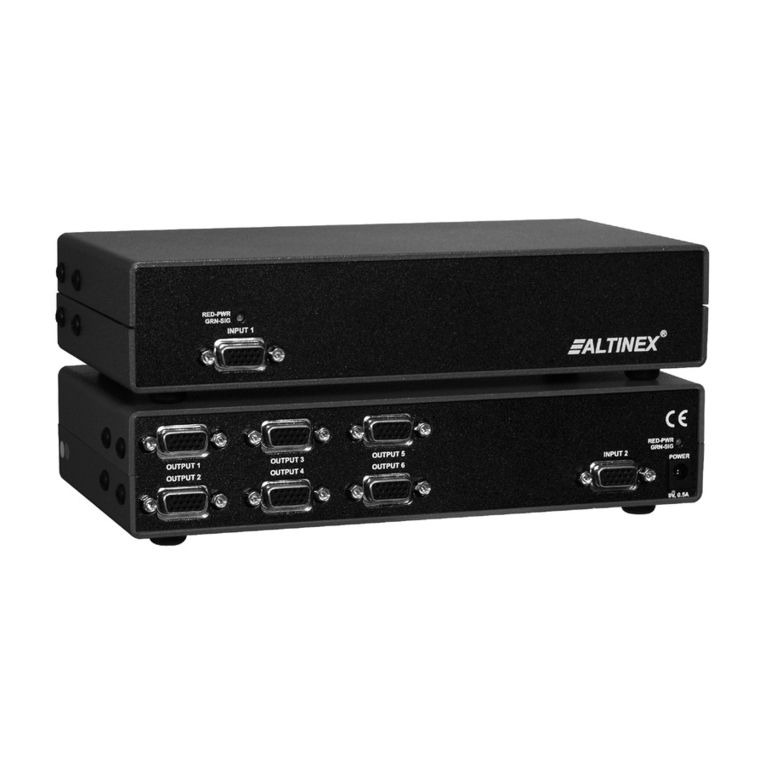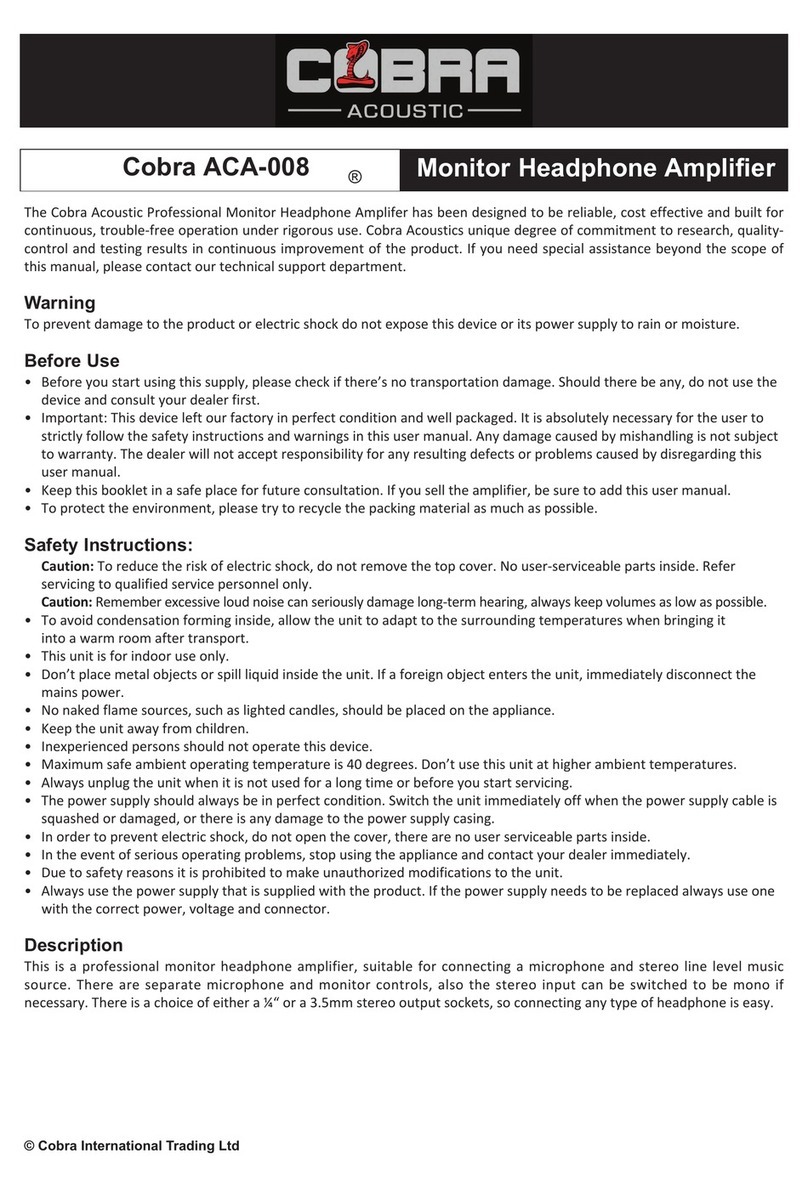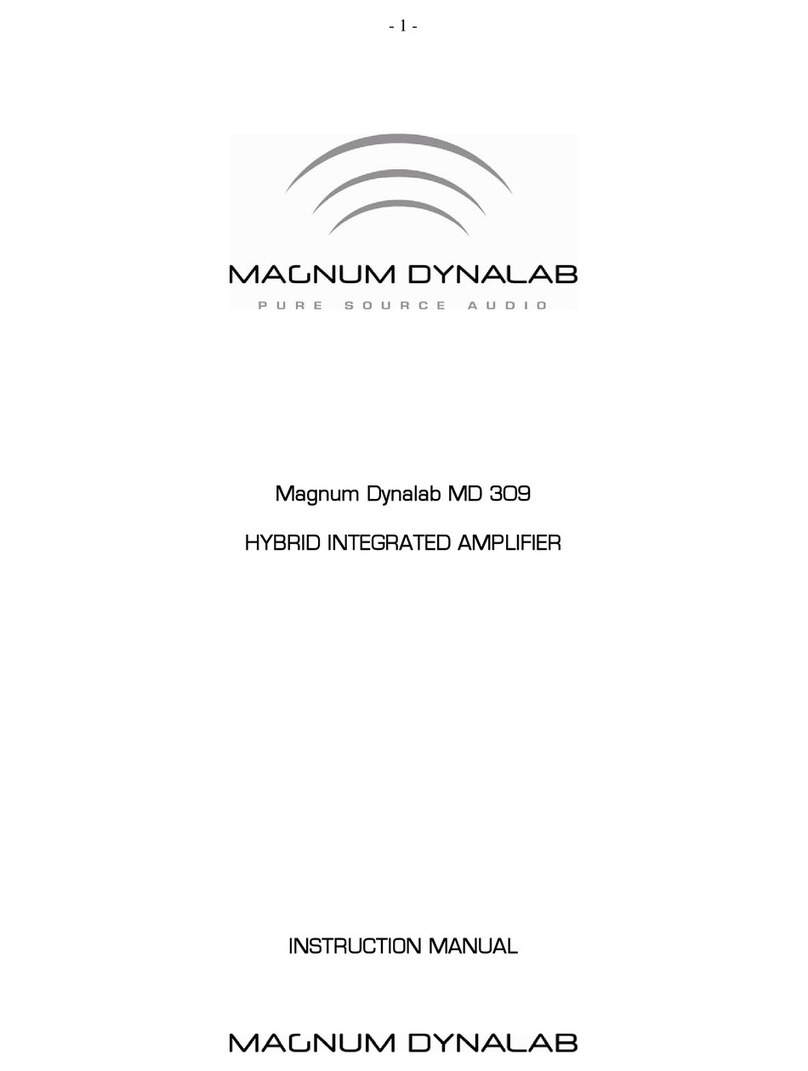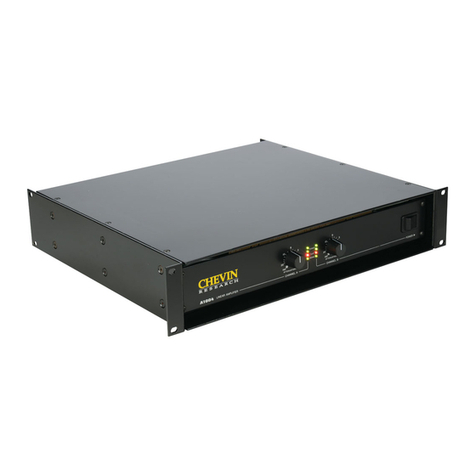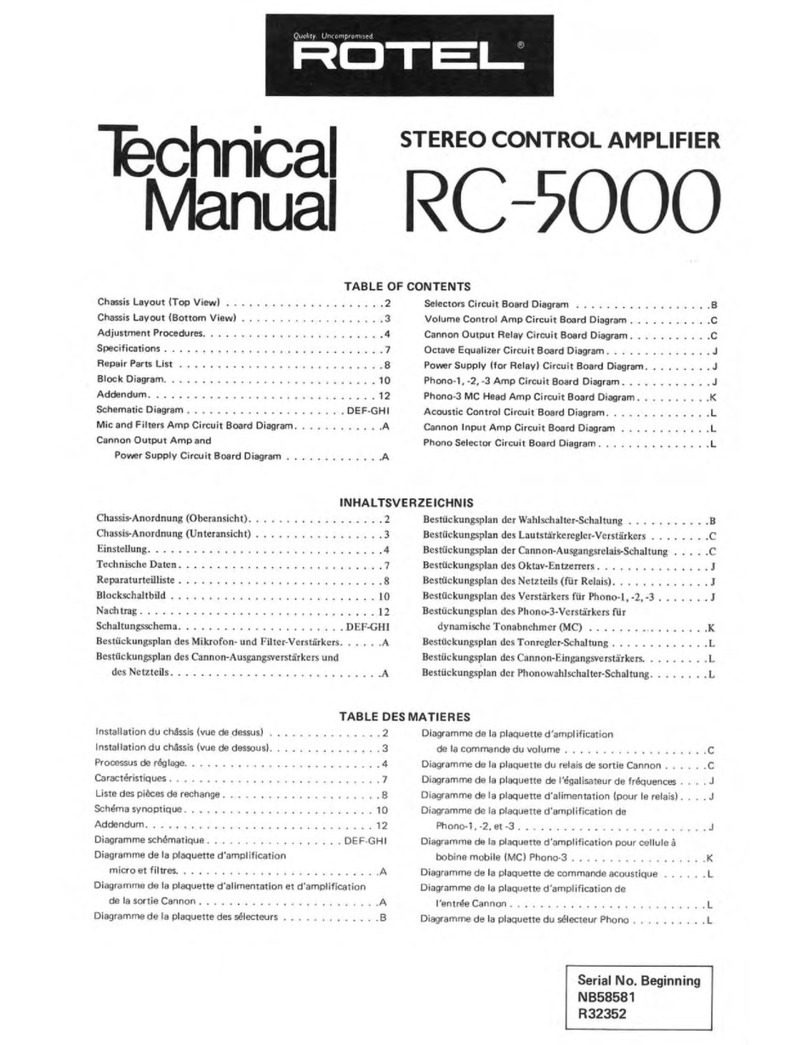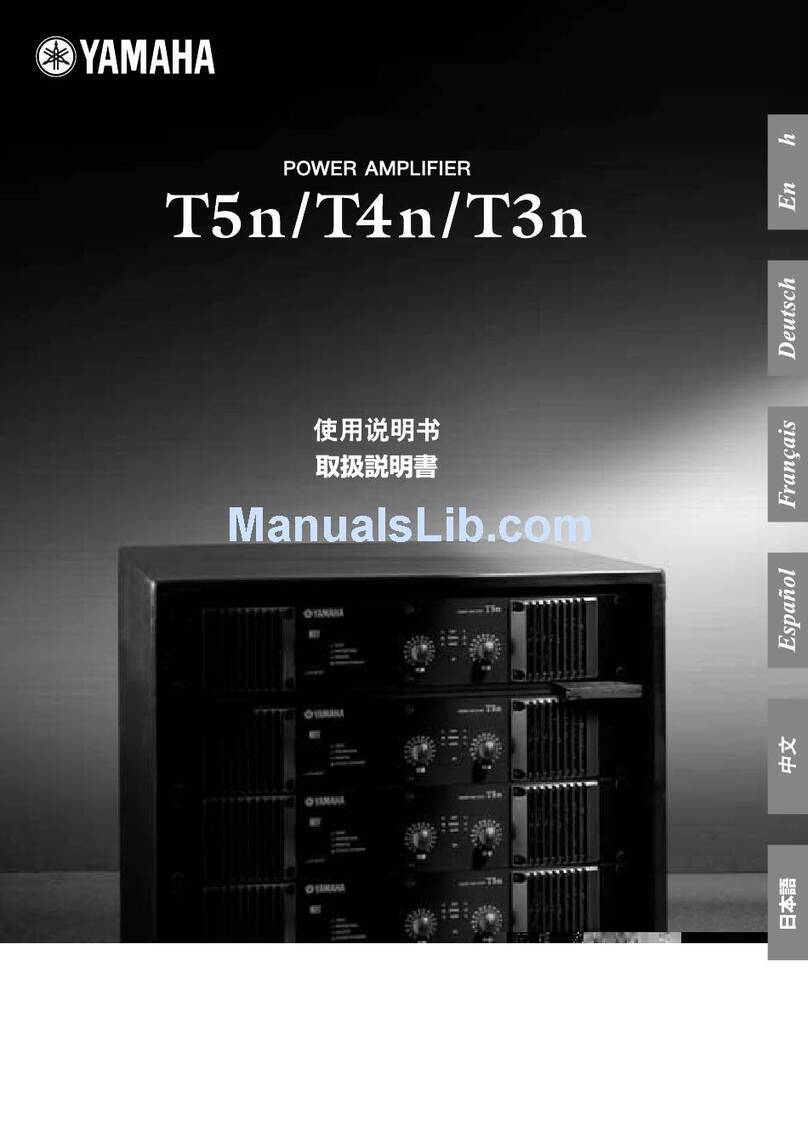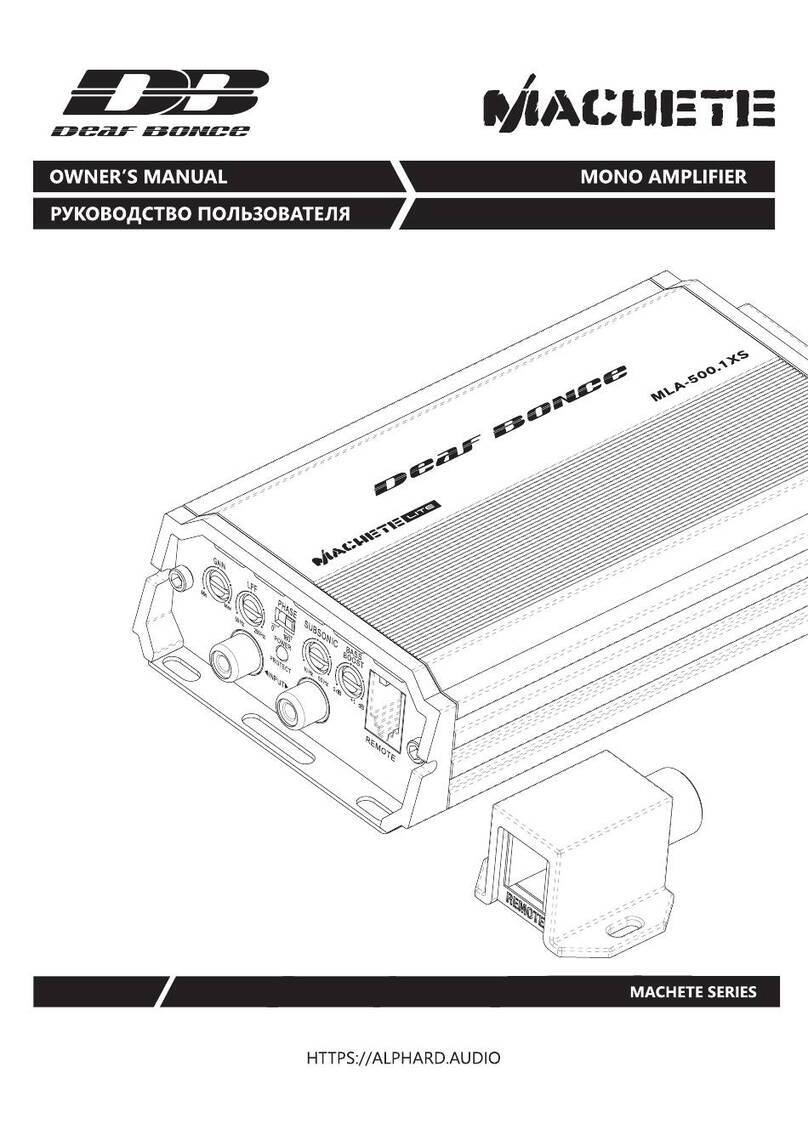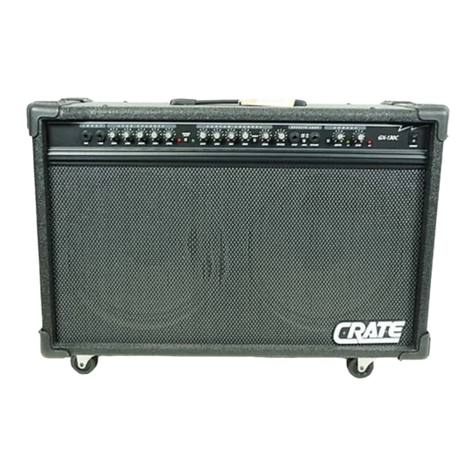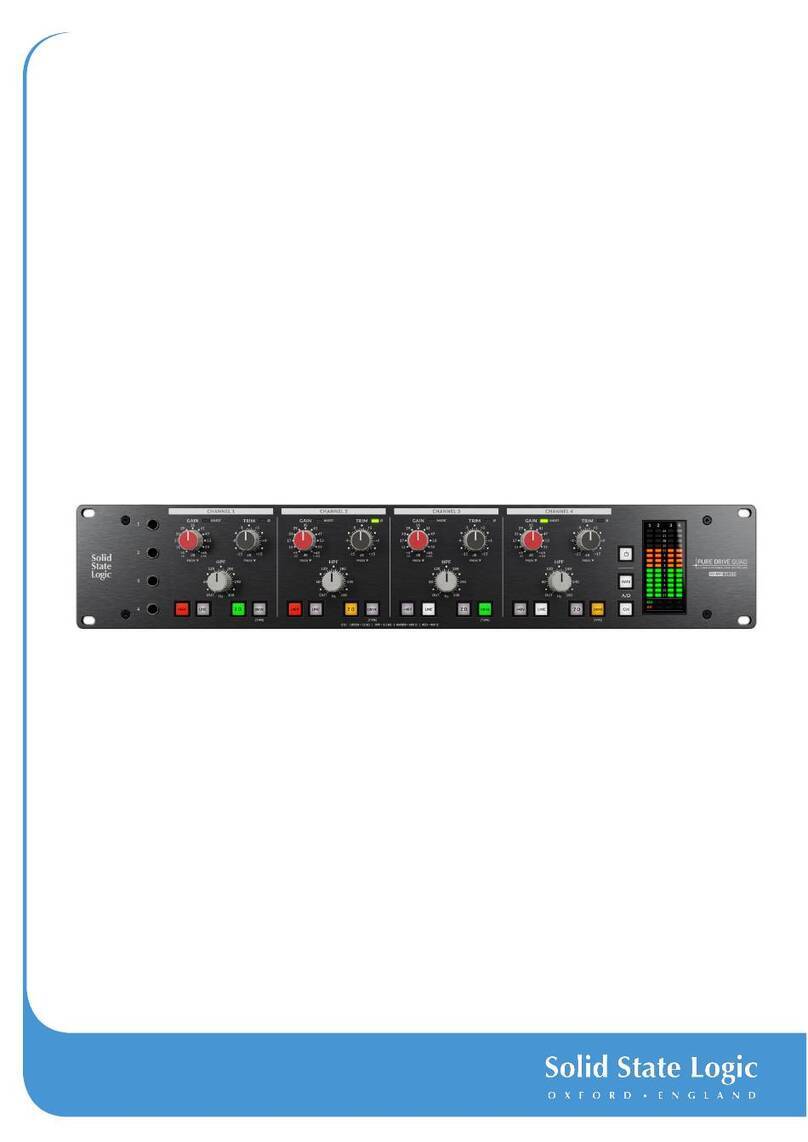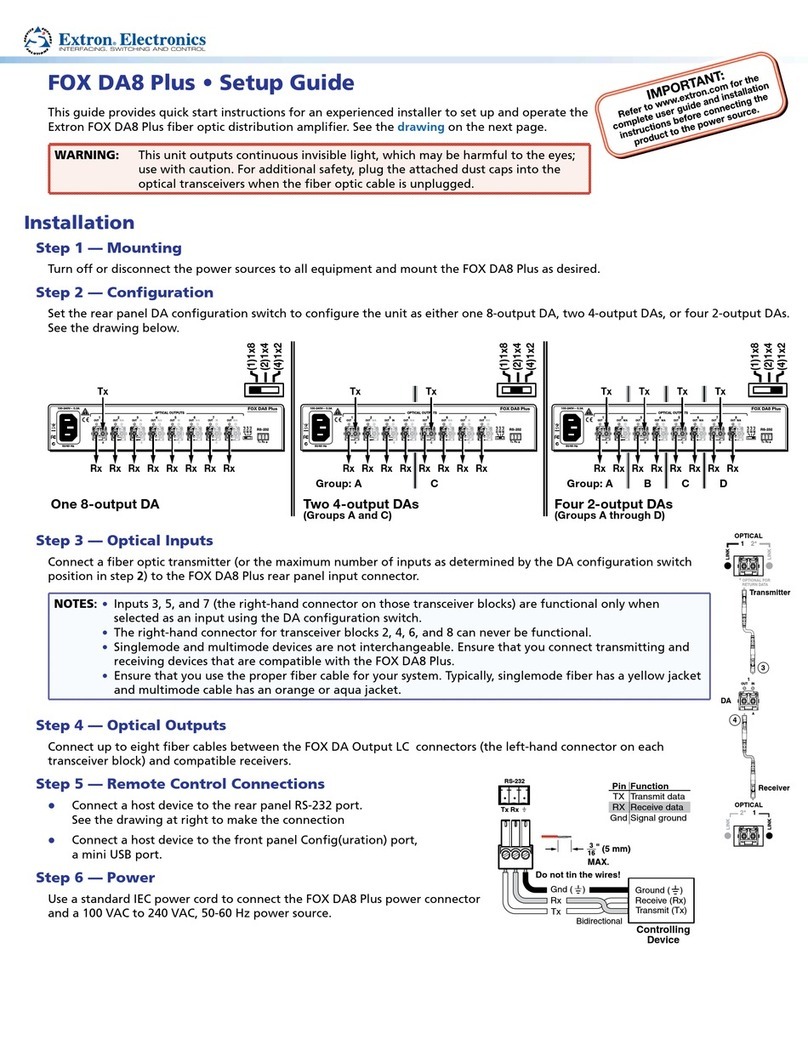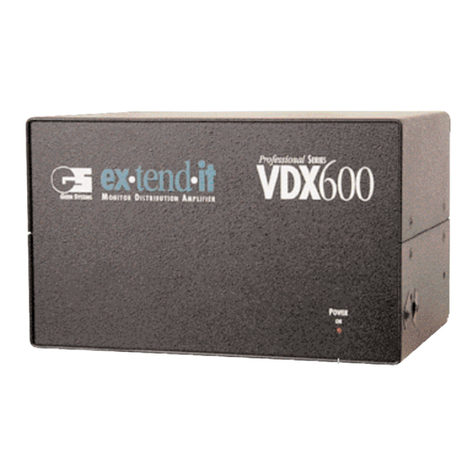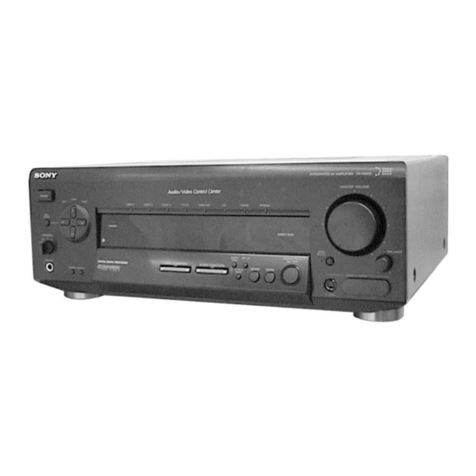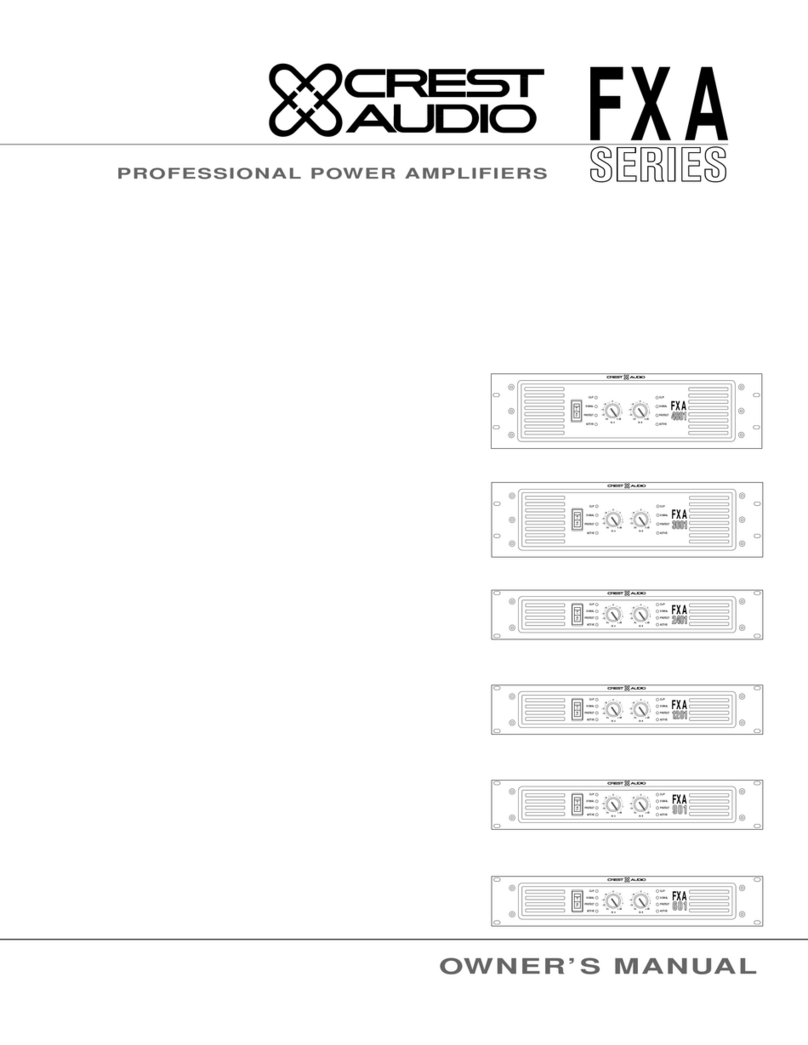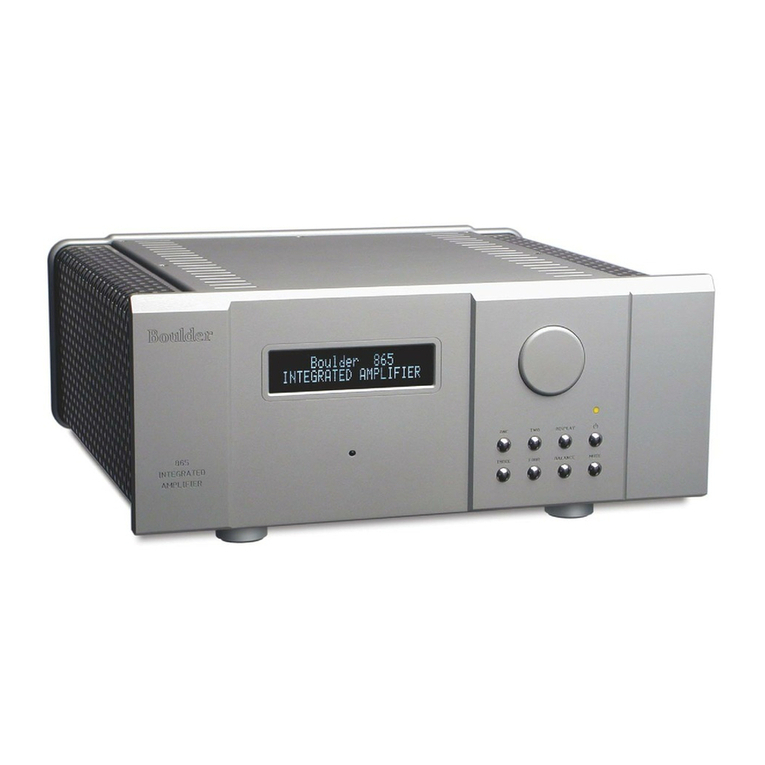Silicon Chip Currawong User manual

siliconchip.com.au
28
SILICON CHIP
CZ),
rairrow
sfo
5010
6
'
•
OOP
The Currawong amplifier is a tried and tested valve amplifier
circuit which has been adapted to components which are readily
available in 2014. Each channel uses two 12AX7 twin triodes for
the preamp and phase splitter stages and two 6L6 beam power
tetrodes in the class-AB ultra-linear output stage. It performs very
well, with low distortion and noise.

od)
This progress view of the amplifier
shows it sitting in its timber plinth
but without the protective Perspex
covers in place to protect the PCB
and protect the user from high
voltages.
e-
•
10W per channel
•
Low distortion
•
Good performance
•
Easy to build
I
N DESIGNING this amplifier, we
wanted to present a unit which is
straightforward to build and which
has a good appearance. To satisfy
the first requirement, most of the cir-
cuitry, with the exception of the power
transformers, is mounted on a large
double-sided PCB. Hence there is no
need for point-to-point wiring from
valve sockets, tag-strips, tag-boards
or any of that stuff from 60 years ago.
Using the large PCB also means
that we have avoided the need for an
expensive metal chassis. Instead, the
PCB slides into a timber plinth stained
as rosewood (although you can have
any timber finish you desire). As a nice
finishing touch, most of the PCB will
be covered and protected by a Perspex
cover. This will prevent little fingers
from touching any part of the circuit
and remove any risk of electric shock
which would otherwise be possible.
We hope you will like the appearance.
There are two toroidal power trans-
formers used to power the Currawong
and these are concealed underneath
the PCB, towards the back of the unit.
Control panel
At the front of the timber plinth,
there is a small control panel suspend-
ed below the main PCB. This carries
the volume control, the on/off switch,
a bi-colour red/green LED, a blue LED
and the headphone socket. And while
it might seem like a waste to use the
Currawong Stereo Valve Amplifier to
drive headphones, we know from long
experience that readers will definitely
want this feature.
By the way, the red/green LED
comes into play when you first turn the
amplifier on. There is an initial delay
while the valves heat up and during
this time, no HT (high tension or high
voltage) is applied to the plates of the
valves which could otherwise suffer
damage in the long term. So during
this delay, the LED is red. Then, when
the HT is applied, the LED changes
colour to green, indicating that normal
operation is possible.
The other LED is lit when the
headphones are in use. Plugging into
the headphone socket enables a relay
which disconnects the loudspeakers
and connects the headphones via 22052
resistors.
At the rear of the timber plinth is
another panel which accommodates
the RCA input sockets, the binding
post terminals for the loudspeakers
and a fused IEC socket for the mains
cord. Both the front and rear panels are
made from PCB material to provide a
high-quality finish.
The overall performance is sum-
marised in an accompanying panel
and three graphs.
It
gives very good
performance for a valve amplifier.
Circuit concept
A major difficulty in the design of
the Currawong has involved the out-
put transformers. As valve aficionados
will be aware, the output transformer
is usually the most expensive com-
ponent in the circuit, apart from the
valves themselves. Similarly, these
days the power transformer is also
very expensive, simply because there
is no locally available off-the-shelf
unit which can be pressed into service.
Yes, you can purchase imported
power and output transformers but if
we had specified these, the total cost of
the amplifier would have been a great
deal higher. Instead, we have taken a
very unusual approach in selecting
the output transformer by employ-
ing a standard off-the-shelf 15W line
transformer (Altronics M1115) which
would normally be employed with a
professional solid-state PA amplifier
to drive 100V lines.
As a line driver, the transformer's
primary winding is driven by a solid-
state amplifier and it steps up the
voltage in its multi-tapped secondary
winding. In the Currawong though, we
drive the transformers back to front,
with the push-pull valve output stages
driving the 100V windings and the
primary windings becoming the low-
impedance drive for the loudspeak-
ers. Conveniently, the 100V winding
has a centre-tap, which is necessary
for push-pull operation. In addition,
we use some of the other taps for the
"ultra-linear" connection.
Make no mistake though; while
these are low-cost transformers (be-
ing made in large quantities), they
have grain-oriented steel cores, a wide
frequency response and low harmonic
distortion. Better still, the taps on
the primary winding enable it to be
connected for ultra-linear push-pull
operation. On the other hand, selec-
tion of this transformer is one of the
twe limiting factors in the maximum
output power of the Currawong, at
close to 10 watts per channel.
The other factor is the power trans-
former selection. We would have ide-
siliconchip.com.au
NOVEMBER
2014
29

Specifications
•
Channels:
2 (stereo)
•
Valve line-up:
4 x 12AX7 twin triodes,
4
x 6L6 beam power tetrodes
•
HT supply:
-310V, actively filtered
Tested load impedances:
4n, 6Q, sn
•
Output power:
2 x 10W (80, 652), 2 x 9W (40) (see Fig.3)
•
Operating mode:
Class-A (80), Class-A/AB (60, 452)
•
Input sensitivity:
-1V RMS (80, with feedback enabled)
•
Signal-to-noise ratio:
77dB
•
Channel separation:
>60dB, 20Hz-20kHz (40, 652 & 852)
•
Harmonic distortion:
typically <0.1%, 60 & 80 (see Figs.3&4)
•
Frequency response:
±0.6dB, 30Hz-20kHz (see Fig.5)
•
Damping factor:
>20 (80), >10 (40)
•
Mains power draw:
typically 120-130W
•
Other features:
ultra-linear outputs, remote volume control option, delayed HT,
HT soft-start
•
Dimensions:
294 x 304 x 186nnm (W x D x H) including protrusions
ally liked to use a transformer with
much higher secondary voltages but a
specially-designed power transformer
would be much larger and more ex-
pensive, as already noted. Having said
that, there is future potential for this
amplifier to be upgraded with better
(more expensive) transformers to en-
able it to deliver substantially more
output power.
The valves can be replaced without
any disassembly. Their sockets are me-
chanically mounted to the thick (2mm)
PCB to prevent the solder joints from
breaking loose during valve removal
or insertion. The thick PCB also helps
to support the relatively high weight
of the output transformers, which
are mounted on the board for ease of
construction.
Temperature-sensitive components
such as electrolytic capacitors have
been kept away from the high-dis-
sipation components, primarily the
6L6 valves and associated 5W cathode
resistors. However, due to the compact
size we have not been 100% success-
ful; one of the large filter capacitors is
near the output valves. Checks of its
temperature during extended opera-
tion show that direct heat transfer is
minimal and should not be a problem.
Semiconductors
There are some semiconductor
components in this circuit but not in
the audio signal path. Mostly, these
perform power supply filtering, to
get rid of ripple and keep the ampli-
fier quiet. The HT delay and soft-start
circuit is also built using solid-state
components.
We should acknowledge considera-
ble input to the design of this amplifier
from Allan Linton-Smith, the designer
of the Majestic loudspeaker system fea-
tured in the June and September 2014
issues. Allan built the first hard-wired
prototype and the concept was then
considerably refined and transferred to
the final PCB featured in these pages.
Allan also suggested using the Al-
tronics line transformers, based on
a discovery by Grant Wills that they
could be used as cheap and effective
ultra-linear valve output transform-
ers - see http://harne.alplialink.
coin .au/-cambief6A N 8 a mp/G r a lit_
Will s_6 CM5 am 1),h t are.
Circuit description
Fig.1 only shows the circuit for the
left channel signal path. The right
channel is identical and the corre-
sponding component numbers are
provided in blue.
The line-level input signal from
RCA socket CON1 has a 1M52 DC bias
resistor to ground, in case the signal
source is floating. The signal then
passes through an RF-rejecting low-
pass filter comprising a 12052 series
resistor and 100pF ceramic capacitor.
The signal is then AC-coupled to
(nominally)
20kn
logarithmic volume-
control potentiometer VR1 by a 1.50
MKT capacitor. This gives a -3dB low-
end roll-off at 5Hz. Note that depend-
ing on part availability, a motorised
potentiometer with a value as low as
51d2 may be used, in which case the
-3dB point rises to 21Hz.
The wiper terminal of VR1 is con-
nected to ground via a 1MS2 resistor
so that if it briefly goes open circuit
during volume changes, the grid of V1a
does not float. The signal is fed to this
grid via a 221(52 RF stopper resistor.
V1a and V1b form the preamplifier,
which is very similar to Jim Rowe's
design from the February 2004 issue
of SILICON CHIP ("Using The Valve
Preamp In A HiFi System"). Essen-
tially, this consists of two common
cathode amplifier stages in series, with
negative feedback around both.
V1's plates are fed from a filtered
HT
rail
of around 224V DC, somewhat
less than the 308V DC main HT rail
due to voltage drops across the two
RC filter resistors (6.81d) and 471d2).
These filters reduce coupling between
channels, reduce coupling from the
output stage to the preamp stages and
minimise supply ripple reaching the
preamp. The preamp is the most noise-
sensitive section as the signal level is
lowest here.
In fact, because hum can be picked
up from AC-powered heater filaments,
we are running the 12AX7 filaments
from regulated 12V DC.
Self biasing
All valves in the circuit are self-
biased. V1a's anode runs at around
120V, ie, 224V minus the drop across
the 270k0 resistor. With zero bias, a
12AX7 will conduct around 3mA at
this voltage, dropping to near-zero
with a grid-cathode bias of around
-2.2V. With a 3.3kf2 cathode resistor,
V1a's operating point tends to settle at
about 0.3mA and thus the cathode is
1.2V above ground.
The output signal from V1a's anode
is coupled to V1b's grid by a 220nF
capacitor and this grid is DC biased
using a 1M52 resistor to ground. V1b
runs at a higher power than V1a,
with a 68052 cathode resistor giving
an operating current of around 1mA.
Therefore, its anode load resistance is
lower at
1001(0.
The output at V1b's plate is coupled
back to V1a's cathode via a pair of
parallel 470nF polyester capacitors
30
SILICON CHIP
siliconchip.com.au



10
Currawong
THD+N
vs Power
09/10/14 14:40:21
240VAC mains, 1kHz signal, 20Hz-20kHz BW w/AUX-0025, both channels driven
5
...,
III
,
CD
.
U)
a
z
/
+
EM===
==IMI/
0
=
E
r
—
0.5
b
2/
a
Malf
.
0.2
AIWA
'
L
)
,
0.1
in
m
;op
Tn
min
g
Niamillr
-
0.05
MIME
0.02
0.01
01
0.2
05
1
2
5
10
20
Power (Watts)
Fig.3: distortion versus power for a 1kHz sinewave into 412, 651 and 812 load
impedances. Again, both channels are driven for a realistic test. As you
can see, distortion remains low at under 2W and then rises slowly until the
onset of clipping at around 8-10W, depending on load impedance. The best
power delivery is actually for tin loads, with 611 being virtually identical
and 411 being a little lower, clipping at around 9.5W/channel. This is partly
due to output transformer drive impedance mismatch.
(ie, around 1µF) in series with a 9.1k0
resistor. This sets the closed-loop gain
of the preamp section at around
2.75,
so that the following phase splitter
receives around 3V RMS at maximum
volume. Note, however, that there is
also a feedback path from the ampli-
fier's output, which we will cover later.
Phase splitter
The phase splitter is another 12AX7
twin triode, V2. The phase splitter
provides some gain but its main job is
to produce two similar drive signals
with opposite phase for the grids of the
push-pull output stage valves Signal
is coupled to this phase splitter from
V1b's anode via another 220nF poly-
ester capacitor.
V2a operates as an inverter, to gen-
erate the out-of-phase drive signal.
Like V1a and V1b, it is configured as
a common-cathode amplifier. It runs
from a higher HT rail of around 288V
DC which comes from the first HT
RC filter stage (6.8k0/39µF). Its grid
is tied to ground by a 1MQ resistor,
with the voltage across the shared
6.8k0 cathode resistor providing the
required bias potential.
This resistor is shared with V2b (and
both cathode currents flow through
it). V2b's grid is connected straight to
ground so when its cathode voltage
increases, the grid-cathode bias volt-
age decreases. As such, when V2a's
cathode current increases and its an-
ode voltage drops, V2b's bias increases
and thus V2b's anode/cathode current
decreases, causing the voltage at its
anode to rise.
So the signal at V2b's anode has the
opposite phase to that at V2a's anode,
ie, it is in phase with the signal from
the preamp. The 220k0 anode resistor
value has been selected so that the two
output signals have a similar swing
and so that V2a and V2b both operate
with as high an anode voltage as possi-
ble, to give maximum drive amplitude
for the following stage.
These drive signals are applied to
the grids of 6L6 output valves V3
&
V4
via 220nF polyester capacitors. These
grids are again tied to ground by 1M0
resistors and there are 10k0 series
stopper resistors to prevent parasitic
oscillation.
Output stage
V3 & V4 are self-biased using 3300
5W cathode resistors, with around 22V
across each. This gives an operating
current of about 65mA. Each output
valve is powered from the main HT
rail of around 308V, via the primary
windings of T3, for a quiescent power
of around 20W each.
Note that DC and AC currents flow in
the two halves of the push-pull wind-
ing since both plates of the tetrodes
are fed from the transformer centre-tap
connection. However, the magnetic
fields produced by these direct cur-
rents are cancelled, as they flow in
opposite directions. This is important
because otherwise the transformer
would be magnetically saturated.
As the current split between V3 &
V4 changes in response to the input
signal however, an AC magnetic field
is induced which is coupled into T3's
secondary. The resultant voltage drives
the speakers or headphones.
Since the output valve quiescent
power of 20W is around twice the
amplifier's power output of 10W per
channel into 80, this gives Class-A
operation. With lower load imped-
ances (for example, 40), V3 or V4 may
be fully cut off during signal peaks,
giving Class-AB operation.
When the input signal swing is posi-
tive, pin 1 of V2a has a negative swing
and so the current through V3 drops.
At the same time, pin 6 of V2b has a
positive swing and thus the current
through V4 increases. This causes an
increase in current flow from the top
(dotted) side of T3's primary to the
other, resulting in a positive swing at
the dotted side of the secondary. Thus,
the output of the amplifier is in phase
with the input.
T3 also has taps approximately half-
way between each end and the centre
(HT) tap. These are connected to the
screens of V3 & V4 via 470 stopper
resistors, providing the ultra-linear
connection mentioned earlier. This
negative feedback from the trans-
former to V3 & V4 cancels out some
of the transformer distortion. Note that
while the feedback signals are high
amplitude, the screen gain is much
less than for signals applied to the grid,
so the feedback doesn't overpower the
drive signals.
Because the signal levels in the out-
put stage are much higher and since
6L6 valves require much more filament
siliconchip.corn.au
NOVEMBER
2014
33

Chassis/power supply
1 timber plinth with base (details
to come)
1 top cover cut from 3mm clear
acrylic (details to come)
1 small tube acrylic glue
1 front panel, code 01111142, 249
x 30mm
1 rear panel, code 01111143, 248
x 53mm
1 160VA 37+37+15+15V toroidal
transformer (Altronics MC5337)
1 80VA 12+12V toroidal
transformer (Altronics M5112)
4 screw-on 30mm equipment
feet (Jaycar HP0830, Altronics
H0890)
4 M4 x 15mm machine screws
and nuts (for feet)
1 15mm anodised aluminium knob
to suit VR1
1 snap-in fused IEC mains male
socket for 1.6mm panels
(Altronics P8325)
2 M205 250VAC 1A slow-blow
fuses (one spare)
1 red chassis-mount RCA/RCA
socket
1 white chassis-mount RCA/RCA
socket
2 red RCA line plugs
2 white RCA line plugs
2 red binding posts (Jaycar
PT0453, Altronics P9252)
2 black binding posts (Jaycar
PT0461, Altronics P9254)
1 SPST ultra-mini rocker switch,
250VAC rated (Altronics S3202,
Jaycar SK0975)
current than 12AX7s, we run the fila-
ments of V3 & V4 (and V7/V8) from
6.1V AC, slightly shy of the nominal
6.3V, due to compromises made in
power transformer selection. It still
works fine; it just takes a little longer
for the valves to reach
full
emission
after switch-on.
Speaker connections & feedback
A 47052 1W resistor across T3's sec-
ondary ensures that there is some load
even if there is no speaker connected.
This is necessary because operating a
push-pull transformer-coupled ampli-
fier with no load can lead to very high
AC voltages at the valve plates and sub-
sequent flash-over in the valve sockets.
T3's secondary connects to the
1 lm length 2-core mains flex
1 lm length 3-core mains flex
1 200mm length 3mm diameter
black heatshrink tubing
1 200mm length 8mm diameter
black heatshrink tubing
1 200mm length 20mm diameter
black heatshrink tubing
1 lm length heavy duty red hook-
up wire
1 lm length heavy duty black hook-
up wire
1 1m length single-core shielded
cable
1 lm length medium duty black
hook-up wire
1 12-way screw terminal strip
(Jaycar HM3194, Altronics
P2135A)
6 M3 x 25mm Nylon screws and
nuts
1 M4 x 6mm machine screw
2 M4 nuts
2 4mm ID shakeproof washers
1 4mm ID eyelet crimp connector
3 red 6.4mm crimp spade
connectors
12 4G x 9mm self-tapping screws
10 small Nylon cable ties
Main board
1 double-sided PCB, code
01111141, 272 x 255nnm
2 15W 100V line transformers
(T1,T2) (Altronics M1115 — do
not substitute)
2 5VDC coil 3A contact SPDT
micro relays (RLY1,RLY2)
(Altronics S4141B)
speaker terminals via the normally
closed contacts of RLY1 and pluggable
terminal block CON3.
RLY1 is energised if headphones are
plugged into the front panel socket,
disconnecting the speaker and re-
directing the signal to headphone
socket CON5 via a 22051 resistor.
If
LK4
is fitted (and we recommend
that it is), feedback is applied from
T3's secondary to V1a's cathode via
a 470nF capacitor and 221d2 resistor.
Since the output is in phase with the
input, by applying some of the output
signal to V1a's cathode, we effectively
reduce the drive for V1a, giving about
14dB of negative feedback.
There is a limit to how much feed-
back can be applied in this manner due
6 M205 fuse clips (F1-F3)
1 1A M205 slow-blow fuse (F1)
1 3A M205 slow-blow fuse (F2)
1 6A M205 slow-blow fuse (F3)
1 white vertical RCA socket
(Altronics P0131) (CON1)
1 red vertical RCA socket (Altronics
P0132) (CON2)
2 2-way vertical pluggable terminal
blocks (CON3,CON4) (Jaycar
HM3112+HM3122, Altronics
P2512+P2532)
1 PCB-mount switched 6.35mm
stereo jack socket with long pins
(CON5) (Jaycar PS0190)
1 3-way vertical pluggable
terminal block (CON7) (Jaycar
HM3113+HM3123, Altronics
P2513+P2533)
1 5-way vertical pluggable terminal
block (CON8) (Altronics
P2515+P2535)
4 chassis-mount phenolic 9-pin
valve sockets with bracket
(V1,V2,V5,V6) (Jaycar PS2082)
4 chassis-mount ceramic 8-pin
valve sockets with bracket
(V3,V4,V7,V8) (Altronics P8501)
6 2-way pin headers, 2.54mm pitch
(LK1-LK6)
2 shorting blocks (LK4-LK5)
1 5-501(1/ 16mm dual gang log pot*
(VR1)
2 6073B-type mini flag heatsinks
4 M4 x 10mm machine screws
4 M4 shakeproof washers
4 M4 nuts
8 M3 x 15-16mm machine screws
10 M3 x 10mm machine screws
12 M3 shakeproof washers
12 M3 nuts
to the phase shift created by the induct-
ance of T3. We have set the feedback to
give as much distortion cancellation as
possible, while keeping it stable with
capacitive loads.
The circuit as presented is stable
with several microfarads across the
load, even when driving it with a
square wave.
By the way, the 470nF capacitor in
the feedback path is important as it
damps shifts in valve bias in response
to changes in mains voltages and valve
temperatures.
With feedback enabled, input sensi-
tivity is around 1V RMS. Typical CD/
DVD/Blu-ray players produce around
2V RMS so this should be plenty in
most circumstances. With LK4 re-
34
SILICON CHIP
siliconchip.com.au

14 M3 Nylon nuts
22 3mm inner diameter Nylon flat
washers
8 6.3mm M3 Nylon tapped
spacers
2 TO-220 insulating washers and
bushes
1 lm length medium duty blue
hookup wire (250VAC rated)
1 lm length shielded audio cable
1 200mm length 3mm diameter
blue heatshrink tubing
6 small green Nylon cable ties
(maximum 2mm wide)
2 small blue Nylon cable ties
* >
201(12 recommended; substitute
motorised pot for remote control
option (see details in part two
next month)
Valves
4 12AX7 dual triodes (V1,V2, V5,
V6)
4 6L6 beam tetrodes - matched
pairs if possible (V3,V4, V7,V8)
Semiconductors
1 4093B quad NAND Schmitt
trigger IC (IC1)
1 LM/LT1084-ADJ 5A adjustable
low-dropout regulator (REG1)
1 KSC5603D 800V 3A high-gain
NPN transistor (Q1)
3 STX0560 600V 1A NPN high-
gain transistors (Q2-Q4)
3 BC547 100mA NPN transistors
(Q5,Q7,Q9)
2 BC557 100mA PNP transistors
(Q6,Q8)
1 red/green 2-lead bi-colour 3mm
LED with diffused lens (LED1)
moved, the overall gain is much higher
and the input sensitivity is around
350mV RMS for full power. However,
distortion rises to around 0.5% at 1kHz
and >1% at lower frequencies.
Note that the 470nF series capaci-
tors in the feedback network are im-
portant. These form high-pass filters
in combination with the feedback
resistors, with a -3dB point of around
15Hz. If DC feedback is used, the bias
time constants in the circuit form a
type of relaxation oscillator and the
bias voltages never quite settle down,
leading to asymmetric clipping and
other undesirable behaviour.
Power supply
The separate power supply circuit
5 blue diffused lens 3mm LEDs
(LED2-LED6)
1 W04 1.5A bridge rectifier (BR1)
2 1N5408 3A 1000V diodes
(D1,D2)
3 1N4007 1 A 1000V diodes
(D4-D6)
Capacitors
1 22001.IF 25V electrolytic
2 470jtF 400V snap-in
electrolytic
4 100µF 50V electrolytic
2 100jiF 16V electrolytic
5 39µF 400V low-profile snap-
in electrolytic (Nichicon
LGJ2G390MELZ15) (Mouser)
2 1.51.1F 63V MKT
5 470nF 630V polyester
2 470nF 63V MKT
8 2201AF 630V polyester
1 100nF 63V MKT or 50V
multi-layer ceramic
2 100pF ceramic disc
Resistors (1W, 5%)
9 1MQ
2 9.11d2
2 2701(52
4 6.8k52
2 2201(11
2 3.3k52
2 120k52
2 68052
2 100kQ
2 47052
6 47k52
2 220Q
2 221(52
1 8252
5 10k12
4 4712
4 33052 (5W, 10%)
Resistors (0.25W, 1%)
7 1MQ
1 56052
1 1501d2
2 47052
2 10k11
1 33052
2 11(5)
4 12052
is shown in Fig.2. All components, ex-
cept the two power transformers T1 &
T2, power switch S1 and the fused IEC
mains socket, are on the main board.
There are three main power require-
ments for this circuit: the 310V HT rail,
the -12V DC filament supply for the
12AX7s (at around 1A) and -6VAC
for the 6L6 filaments, at around 4A.
We also use the 12V DC rail to power
various ancillary circuits, as described
below.
All of T1's secondaries are con-
nected in series, along with one of
T2's secondaries, to produce 114VAC.
T2's other secondary provides a little
over 12VAC, to run the 6L6 filaments
at around 6.1VAC each, in series pairs.
The 12VAC is also rectified, filtered
siliconchip.com.au
NOVEMBER 2014
35

Most of the parts except mainly the power transformers are
mounted on a single large PCB to make the assembly easy. The
optional remote volume control is built on a separate PCB.
and regulated to provide the 12V DC
rail (actually about 12.3V DC), for the
12AX7 filaments and DC-powered
circuitry.
The 114VAC from CONT is rectified
in a half-wave voltage doubler consist-
ing of 1000V 3A diodes D1 & D2 and
two 470µF 400V capacitors, giving
about 310V across both capacitors with
several volts of ripple. Fuse Fl pro-
vides some protection against faults.
There are two 47142 series-connect-
ed bleeder resistors to discharge the
47011F capacitors when power is re-
moved. Four blue LEDs are connected
in series with the two 47142 1W resis-
tors. The blue LEDs indicate the pres-
ence of HT and also illuminate output
transformers T3 and T4 (very effective
in a room with subdued lighting).
The output stage has no HT low-
pass filter, unlike the preamplifier and
phase splitters. So to prevent HT ripple
in the output stage from affecting the
signal, we are using an active ripple
36
SILICON CHIP
filter. This is a capacitance multiplier
filter built around high-voltage, high-
current transistor Q1, configured as an
emitter-follower.
The traditional HT filter is a large
iron-cored choke but these are heavy
and expensive, not to mention hard to
find these days. Our transistor-based
method is more effective and cheaper.
Q1 is driven by Q2 and Q3 which are
high-voltage high-gain signal transis-
tors, in a "Triplington" configuration;
it's like a Darlington but with an extra
stage. The higher the gain in this buffer,
the more effective the filter is. Base
bias comes from an RC low-pass filter
across the incoming HT rail, consisting
of a 11‘4,0 resistor and 470nF polyester
capacitor.
Q2 and Q3 have a gain of around 70-
100 each while Q1 has a gain of around
30. So the overall gain is about 70 x 70
x 30 = 147,000 which multiplies the
effect of the 470nF capacitor to act as if
it is 69,000g! In practice, it isn't quite
as good as this as the 470nF capacitor
discharges slightly through the three
base-emitter junctions at the trough
of each ripple cycle but despite this,
the ripple at Q1's emitter is just a few
hundred millivolts.
Q1 has an integral emitter-collector
diode so that when the unit is switched
off, the output filter capacitors can
safely discharge back into the input
filter capacitors without doing any
damage. D4 protects Q2 while D5
provides similar protection for Q3 but
also has a role in the start-up delay,
which we'll explain later.
Note that this arrangement also
results in HT "soft-start" as it takes
a few hundred milliseconds for the
470nF capacitor to charge and the HT
rail tracks this voltage.
Turn-on delay
We have also incorporated a 20-sec-
ond (or so) turn-on delay, to allow the
valve filaments to heat up before HT
siliconchip.com.au

20
50
100
200
500
1k
Frequency (Hz)
Fig.4: distortion versus frequency, with both channels driven at 1W into
three different resistive loads. As you can see, the distortion is pretty low
for a valve amplifier, especially between 100Hz and 10kHz. Below 100Hz,
distortion rises steeply due primarily to the output transformer's non-linear
response. Distortion into lower impedances is only slightly worse than that
for 812. Note the 80kHz bandwidth used, to ensure that higher frequency
harmonics are included in the measurements.
2k
5k
10k
20k
CD
0.2
0
E
0.1
0.05
0.02
0.01
The PCB is slid into a slot that runs around the top inside
of the timber plinth. Perspex covers will be used to protect the
PCB and speaker transformers.
09/10/14
14:35:26
240VAC mains, output level 1W, 20Hz-80kHz bandwidth, both channels driven
-
.
I
M
Ill
ME
\
II.
ZINN,
Miblk
40_.....d
...
244
-.Ad
11:W
80
_....w.-
-
,wm
_...o
.
..._
r
io Currawong THD+N vs Frequency
5
2
or
t
ion
+ No
ise
0.5
is applied. Part of the rationale for
this is to prevent "cathode stripping"
which can occur with cold cathodes,
although the existence of this phe-
nomenon is somewhat controversial.
But since the valves aren't "ready"
to operate immediately anyway, it
certainly doesn't hurt to delay the
application of HT.
IC1 is a quad Schmitt-input NAND
gate which runs from the 12V rail and
provides the turn-on delay. Note that
ground for the 12V rail is labelled
VEE
and will be close to, but not necessarily
at, GND (OV).
IC1a is connected as an inverter
with a 100uF capacitor from its input
to ground. A 1501(12 resistor charges
this capacitor from the 12V rail while
a 1MS2 capacitor discharges it when
power is switched off. It takes about
20 seconds for this capacitor to charge
to a sufficient voltage for the output of
IC1a to go low.
During this time, IC1a's output is
high. This is inverted by IC1c and then
again by IC1d, so Q4 (another 600V
transistor) is switched on initially.
This keeps the 470nF capacitor in
the HT filter from charging until the
delay has ended. Diode D5 in the HT
filter prevents the base of Q3 from
being pulled below GND when
VEE
is
(slightly) negative.
IC1a and IC1c also drive LED1 via
two pairs of complementary emitter-
followers (Q5-Q8). LED1 is a bi-colour
device and consists of a red LED and
green LED on the same die, connected
in inverse parallel. Since inverter IC1c
is between them, one inverter is always
driving one end of LED1 high and the
other is driving it low. Thus LED1 is
red initially at turn-on and switches
to green once the time-out period has
expired and the HT rail is powered up.
A 1k0 resistor sets the LED current
to about 10mA while another
ikn
re-
sistor partially isolates the bases of Q5
& Q6 from IC1a's output. This allows
the optional remote control board to
independently drive LED1, in order to
flash it to acknowledge infrared com-
mand reception. The remote control
board connects via CON10 and will
be described next month.
Low-voltage supplies
5-pin pluggable terminal block
CON8 provides separate low-voltage
AC connections for the 6L6 filaments
(pins 1 & 3) and the regulated supply
(pins 4 & 5). Each is fused on the board.
However, we ultimately decided to use
one transformer winding to power both,
hence they are wired in parallel despite
the separate connections.
The 12VAC from pins 4 & 5 of CON8
is rectified by 1.5A bridge rectifier BR1
and filtered with a 2200µF capacitor
to produce around 15-16V DC with
siliconchip. corn. au
NOVEMBER 2014
37

+3
Currawong Frequency Response
09/10/14 14:58:07
A0
+2.5
+
2
Eii
-
+
+1.5
-0
.
k
_,
II
i +0.5
El
i
7
>
co +0.0
,
11111
40 ,
60
7
3
-0.5
g
_
r
I
1
80
<
-1.5
F
II
t
1
i
II
1
- 2.5
-3
1 0
20
50
100
200
500
1k
2k
5k
10k
20k
50k 100k
Frequency (Hz)
Fig.5: the frequency response is pretty flat in the audible range (note: the
vertical scale is only ±3dB for the entire diagram). Roll-off at the high
frequency end is -3dB at around 50kHz while the low-end -3dB point is
below 10Hz. The peak at around 20Hz is partly due to the AC-coupled
global feedback and partly due to greatly increased waveform distortion
below about 30Hz due to the output transformers. However, the peak
amplitude is only around +1.5dB and 20Hz signals are barely audible.
about 1V ripple. This is regulated to
provide a nice smooth rail by REGI, a
low-dropout, high-current equivalent
to the LM317.
Pins 1 & 3 of CON8 connect straight
to the series/parallel-connected 6L6
filaments and as a result, they get about
6.1VAC each. One end of this AC sup-
ply is grounded for noise immunity.
Now because of this ground connec-
tion and the fact that the same trans-
former secondary is used to feed BR1,
the negative end of BR1 actually floats
between about +0.7V and -15V. Hence,
the need to disconnect VEE from GND.
If two separate 12V transformers or
windings were used, LK6 could be
fitted and thus VEE would be at the
same potential as GND. LK6 must not
be fitted with the supply arrangement
shown here!
The circuit will work the same re-
gardless as to whether VEE is connected
to GND, as Q4 is the only connection
between the two supply "domains".
The DC supply is also used to power
relays RLY1 and RLY2 when head-
phones are plugged in. These are 5V
relays, so an 8252 series resistor drops
the 12V DC to an appropriate voltage.
LED2 is also connected across the relay
coils, in series with a 33052 current-
limiting resistor, to indicate when the
speakers are disconnected.
Unused linking options
Note that the supply was also de-
signed to operate with the regulated
rail at 6V DC rather than 12V. This
would require a different transformer
(ie, 6VAC rather than 12VAC) and
the option was provided as there are
some 12AX7-compatible valves with
6.3V-only filaments (rather than the
typical arrangement with a 12.6V
centre-tapped filament).
However, given the relative rarity
of these valves, we aren't going to go
into details as to how to reconfigure
the supply except to say that LK1-LK3
are fitted for this purpose. Normally,
they are left out.
PCB layout
We wanted to put as many parts
on the PCB as possible to make this
amplifier easy to build. Soldering parts
to a PCB is certainly a lot easier than
mainiciu
Note: parts of this circuit operate at over
300V DC. Do not touch any components
or any part of the PCB while the unit is
operating or immediately after switch
off. The blue LEDs in the circuit indicate
when dangerous voltages are present.
point-to-point wiring! It minimises the
chances of mistakes and also means
that performance will be consistent
between amplifiers.
The PCB layout was a bit tricky
though, due to the voltages involved.
We have kept tracks with voltages
that may differ by over 60V apart by
2.54mm to prevent arcing, while in
other areas low-voltage tracks need
to be closer together so they can fit.
We also used "star" earthing as much
as possible to avoid hum and ripple
injection into the preamp stages. Most
of the grounds on the board converge
on the main power supply filter capaci-
tor negative pin.
The board has been designed with
plated slots for the valve socket pins
so that they fit snugly and neatly.
All connectors have been placed
along the back of the board, on the
underside, to keep the chassis wiring
neat. The input signals run from the
back of the board to the front (where
the volume pot is mounted) through
shielded cables that are strapped to the
underside of the board, to prevent the
low-level input signals from picking
up ripple, hum and buzz.
We have also used low-profile
components where possible, so that a
clear perspex shield can be fitted over
the top, to prevent prying fingers from
getting a shock, as mentioned earlier.
The valves, main filter capacitors and
output transformers will pass through
cut-outs in this shield, with perspex
boxes around the transformers. The
rest of the components will be safely
underneath.
Next month
That's all we have room for this
month. Over the next couple of months
we will present the main PCB layout
diagram, describe the assembly proce-
dure, explain how to build the plinth
and finish the wiring. We'll also go
through the testing and troubleshoot-
ing procedure and describe the op-
tional infrared remote control which
uses a motorised potentiometer. SC
38
SILICON CHIP
siliconchip.com.au

By Nicholas Vinen
The Guntawong Stereo
IOW Valve Amplifier, NI
In Pt.1 last month, we described the circuit
and presentation of
our new Currawong stereo valve amplifier.
We now describe the
PCB assembly and detail the timber plinth
and chassis wiring
along with detailed instructions on putting
it all together.
M
OST OF
THE
parts for the Cur-
rawong are mounted on a single
large PCB. This then slides into a slot
near the top
of a
timber plinth, with
the remaining components — primar-
ily the two large power transformers
— underneath the PCB and attached to
the plywood or MDF base.
The front panel carries the head-
phone socket, volume control, power
switch and status LEDs. The input
connectors, loudspeaker terminals and
power socket are mounted on the rear
panel which is recessed into a cut-out
in the rear of the plinth.
82
SILICON CHIP
So let's start putting the main PCB
together, which is a significant part
of the work involved in building the
Currawong.
PCB assembly
Start the PCB assembly with refer-
ence to overlay diagram Fig.6. The
board is coded 01111141 and measures
272 x 255mm. It's 2mm thick, which
makes it more rigid and stronger than
typical 1.6mm laminate.
Start by fitting the smaller resistors.
The
colour-coded stripes on small
resistors aren't always distinct so it's
best to check each value with a DMM.
Use the lead off-cuts to make the two
wire links (next to LK4 and LK5).
Follow with the three 1N4007 di-
odes (D4-D6), in the top corners of the
board, with the striped cathode ends
towards the right or bottom of the PCB
as shown. IC1 can go in next — there's
no need for a socket. Check that its pin
1 notch/dot is towards the left side of
the board before soldering it.
Then fit all the
1W
resistors. Their
colour codes are usually clear however
it doesn't hurt to measure them to be
sure. None of these run hot so they
siliconchip. corn. au

r
=40e4,
,,
ke4
This view shows the completed PCB
assembly for the prototype amplifier,
with the front-panel fitted. It's housed in
a timber plinth and fitted with Perspex
covers to protect the user from high
voltages.
\ARMING! MOM VOLTAGES
High AC and DC voltages are present in this circuit. In particular, mains
voltages (230VAC) are present on the IEC socket and the primary side of the
mains transformers (including the wiring to the power switch). In addition, the
transformer secondaries together provide a 114VAC output and the power
supply produces an HT voltage in excess of 300V DC which is present on
various parts of the amplifier circuit (including the output transformers).
Do not touch any part of the amplifier or power supply circuitry when
power is applied otherwise you could get a severe or even fatal electric
shock.
The blue LEDs in the circuit indicate when high voltages are present. If they
are lit, the power supply and various parts on amplifier board are potentially
dangerous.
The completed amplifier must be fitted with Perspex covers
as described in Pt.3 next month to ensure safety.
can be mounted in contact with the
PCB. You may find it difficult to get the
specified 9.11d21W resistors, so 8.21(52
resistors can be used instead with only
a minor impact on performance (don't
use 101(52 as this may prejudice overall
stability).
The two large 1N5408 power diodes
are next, with both cathode stripes
facing the bottom of the board. These
will get a little warm so we recom-
mend spacing them about 5mm off
the board (eg, using a 5mm-wide strip
of cardboard as a temporary spacer).
The W04 bridge rectifier can also go
in now; again it's a good idea to space
it off the board a little.
Next, fit blue LEDs3-6. These have
a dual purpose: to indicate the pres-
ence of HT and to illuminate the
transformers. They also form part of
the HT bleeder circuit so must not
be left out (if you must omit them,
use wire links in their place). Angle
each one back so that it will shine on
either T3 (LED5, LED6) or T4 (LED3,
LED4) and make sure the longer anode
siliconchip.com.au
leads go through the holes closer to
the righthand side of the board.
Now you can mount all the TO-92
package small signal transistors, ie,
Q2-Q9. Don't get the three different
types mixed up. Follow with the six
fuse clips. Check that the fuse reten-
tion lugs are on the outside before
soldering the clip in place, otherwise
you will not be able to fit the fuses.
Also make sure that they are pushed
all the way down onto the PCB before
soldering them in place.
Next on the list are transistor Q1
and linear regulator REG1. These are
both fitted with small heatsinks and
it's important that the heatsinks are
isolated from the device tabs using
DECEMBER 2014
83

D
O
z
O
12.6VAC 6/12VAC
I• • 'I
•
O
11AVAC In
•
Aix
I
•
• •
0
Lek Output
•
•
DC Out
+ -
•
•
Left Input
•
-
o
+
- •
12001-*
Right
•
•
•
- ; - • •-[ 1M
k
120u I.
WO4
LK6
COM_
•
• 80
G4C
).
•-1 10k 1
-
•
BC547
REG1 1M LT1084-ADJ
Insulating
washer
& bush
OUTPUT
TRANSFORMER
T3
INSI
TERMIN.
,
HEATS
.
-
100µF
INSULATE TRANSFORMER
TERMINALS WITH DOUBLESLEEVE
HEATSHRINK TUBING (SEE TEXT)
1004
50V
et
• • • •
•
•
•
1.25W 2.5W 5W 10W 15W
COM
O
C
z
I-
0
O
z
00
0
0
to
so
Lf1
.st
•
—.1 470 1V,
H 10k 1W
H 1M 1W
LU
QR
(NI
V3 6L6
H 470 1W 1—•
is—I 470 1W
H
lok
iw
H
1 M
1w.H.
ickJw
470nF 63V
5
0
FEEDBACK
220nF 630V
220nF 630V
•
')
220nF 630V
470nF 630V
470nF
470nF 630V
a
0
•
CONE
O
0 0
•
•
0 .
01111141
470n1
630V

o-{
4700 }•
•
-(
1 k
F.
• •
0
100µF
16V
Right
•
- - •
•
•
0
1
M
0100pF
•
-t
120o
J-•
ok 1W
H
•
•
470nF(
D5
•
—•1 1M 1W H
•-11200
COM 80
H
47k 1W
F.
47k 1
w
H
630V
INSULATE TRANSFORMER
TERMINALS WITH DOUBLE-SLEEVE
HEATSHRINK TUBING (SEE TEXT)
U
0
0
,
r>
100LLF
10011F
50V
H
470 1W
H
470 1W 1—•
H
10k 1W l•—•
H 1M 1W
H 1M 1W 1—•
•—I 10k 1W H
470nF 63V
220nF 630V
220:F
470nF 630V
470nF 630V
1
.
-
1
150k
1-•
IC1 4093B
630V
Right Output
+ - o
©2014
0
QA
STX0560
0
Fig.6: the parts layout on the top
of the PCB. This diagram has been
split and the righthand side partly
duplicated where it meets the
magazine gutter, for clarity. The text
describes how the valve sockets are
mounted; they must be mechanically
secured before the pins are soldered.
Note that D1, D2 and the 5W resistors
should be stood off the board to allow
air to circulate around them and don't
forget to insulate Q1 & REG1 from
their heatsinks.
insulating
washers and bushes — see
Fig.7.
In
each case, start by bending the
leads of.the TO-220 device so they fit
through the pads on the board, with
the tab hole lined up with the PCB
mounting hole.
Note that Q1's centre lead is bent
closer to the package than the other
two
(due
to the high voltage between
the pins) but this is not the case for
REG1.
To mount each device, place an
insulating bush in the tab hole, then
feed an
M3 x 10mm
machine screw
through from the top. Slip an insulat-
ing washer under the device, over the
screw thread, then slide the heatsink
on from underneath. Drop this assem-
bly
onto the PCB,
ensuring all pins go
through their respective holes, then
use a shakeproof washer and M3 nut
to hold it in place.
In
each
case, ensure the heatsink
and insulating washer are straight
before tightening the nut fully, then
solder the leads. That done, fit the two
relays, making sure they are nice and
flat on the PCB before soldering more
than two pins.
Now it is time to install the ceramic
capacitors, followed by the MKT
(metallised polyester) capacitors, in
increasing order of height. Follow with
the six pin headers for LK1-LK6. Try
to solder these flat on the board and
neatly aligned with the edges of the
board for best appearance.
You can then bend the leads of the
Fig.7: the mounting details for transistor
Q1 and regulator REG1. In each case,
the device tab must be isolated from the
heatsink using a silicone insulating washer
and insulating bush.
DECEMBER 2014
85
FLAG
HEATSINK
01
PCB
M3 x 1 Omm
SCREW
1
1 INSULATING
BUSH
I I
I
SILICONE
WASHER
L
STAR
M3 NUT'
WASHER

The 9-pin sockets are secured using
M3 x 10mm machine screws, with a
Nylon nut & two Nylon washers used
as spacers at each mounting point.
Since publishing Pt.1 last month,
we've made a few small changes
to the chassis arrangement and
this affects the list of parts required.
Please note the following changes:
Main board
(1)
Delete vertical RCA sockets
for CON1 & CON2; add short
stereo RCA-RCA lead
(2)
2 x 8.2k51 1W resistors can
be used instead of the 2 x
9.1kS2 1W resistors listed
Revised chassis parts
1 timber plinth with base (see text)
1 top cover cut from 3mm clear
acrylic (details to come)
1 small tube acrylic glue
1 front panel, code 01111142, 249
x 30mm
1 rear panel, code 01111143, 248
x 53mm
1 160VA 37+37+15+15V toroidal
transformer (Altronics MC5337)
1 80VA 12+12V toroidal
transformer (Altronics M5112)
4 screw-on 50mm equipment feet
(Jaycar HP0832)
1 15mm anodised aluminium knob
to suit VR1
1 snap-in fused IEC mains male
socket for 1.6mm panels
(Altronics P8325)
2 M205 250VAC 1A slow-blow
fuses (one spare)
1 red chassis-mount RCA/RCA
socket
1 white chassis-mount RCA/RCA
socket
2 red binding posts (Jaycar
PT0453, Altronics P9252)
2 black binding posts (Jaycar
PT0461, Altronics P9254)
1 SPST ultra-mini rocker switch,
250VAC rated (Altronics S3202,
Jaycar SK0975)
1 lm length 2-core mains flex
1 lm length 3-core mains flex
1 200mm length 3mm diameter
black heatshrink tubing
1 lm length 5mm diameter clear
heatshrink tubing
1 200mm length 20mm diameter
black heatshrink tubing
1 50mm length 50mm diameter
black heatshrink tubing or large
insulating boot (Jaycar PM4016)
1 lm length heavy duty red hook-up
wire
1 lm length heavy duty black hook-
up wire
1 500mm length figure-8 speaker
wire
1 12-way screw terminal strip
(Jaycar HM3194, Altronics
P2135A)
1 M4 x 10mm machine screw
2 M4 nuts and shakeproof washers
2 yellow 5.3mm ID eyelet crimp
connectors
2 red 8.4mm ID eyelet crimp
connectors
5 red 6.4mm insulated spade crimp
connectors
4 solder lugs
1 5mm cable clamp (P-clamp)
12 black 4G x 12mm self-tapping
screws
12 4G x 9mm self-tapping screws
1 4G x 6mm self-tapping screw
1 3mm ID flat washer
7 3mm ID spring washers
10 small Nylon cable ties
four 5W resistors to fit through their
mounting holes. There are two pairs
of holes for each; we used the inner
pair but it isn't mandatory. As with the
1N5408 diodes, use a 5mm spacer to
stand each resistor off the board. Keep
them level and straight for a tidy result.
The 630V polyester capacitors can
then be fitted. The PCB is designed
with multiple pads for each capaci-
tor, to suit different lead spacings. If
you have an odd one, you may need
to bend its leads out however most
should drop straight in. Refer to Fig.6
to see which type goes where.
Now solder the smaller electrolytic
capacitors in place, ie, the six 1001,tF
types. In each case, ensure that the
longer (positive) lead goes in the pad
closer to the front edge of the board,
as shown on Fig.6.
Valve sockets
The valve sockets are secured to the
board before soldering, so the solder
joints aren't under stress. The speci-
fied sockets have solder lugs and the
board has been designed with slots to
accommodate them.
Start with the smaller 9-pin sockets.
Feed M3 x 10mm machine screws
through the top mounting holes and
tighten Nylon nuts on the underside.
Slip two Nylon washers over each
screw thread, then pass the screws
down through the mounting holes
This mock-up shows the final mounting
arrangement used for the 8-pin sockets
(it differs slightly from that used on the
prototype). These sockets are secured
using M3 x 15mm screws and M3 x
6.3mm tapped Nylon spacers.
on the board, guiding the solder lugs
through the slots. If it won't go in,
check that you have the right orienta-
tion as it will only fit one way.
You may need to put the solder lugs
under a small amount of tension to get
them to go through the slots, due to the
way they are angled. But once they all
line up it should slip into place and
you can push the socket right down
so it's sitting on the Nylon washers.
Use a shakeproof washer and M3
nut to secure the screw closest to the
front (bottom) edge of the board. Fit
a Nylon washer and nut to the other
(this is necessary to avoid shorts to
adjacent PCB tracks) — see Fig.8. Do
both nuts up tightly, check that the
socket is sitting level on the PCB and
then solder the pins and repeat for the
other three sockets. It isn't necessary
to trim the solder lugs after soldering.
For the larger 8-pin sockets, the ar-
rangement is similar but their mount-
ing brackets are supplied separately.
Take a bracket and feed M3 x 15mm
machine screws through the top of
the mounting yokes (see photos), then
loosely screw M3 x 6.3mm Nylon
tapped spacers on, just tightly enough
86
SILICON CHIP
siliconchip.com.au

Another view of the completed PCB assembly, this time taken from the rear. Check the board carefully after assembly to
ensure that all polarised parts are correctly orientated. Note that the 22000 capacitor indicated by the red arrow must
be mounted horizontally (ie, on its side) as shown in Fig.6, not vertically as shown here.
so that the screws stay in place.
Now position this assembly over
the PCB and adjust the spacing so that
the two screws are equally far from
the centre of the mounting bracket
and they pass through the appropri-
ate holes on the PCB. You can then
remove the bracket and drop the socket
in place. Some "jockeying" may be
required but it should fit easily once
you get all the pins lined up.
These sockets can
be installed
with eight different orientations but
only one is correct. The notch in the
central hole must
face towards
the
lefthand side of the PCB. If you solder
one incorrectly, it will be difficult, if
not impossible to remove (see Fig.6).
With the socket pushed down onto
the PCB and orientated correctly, slip
the bracket on top and secure it in posi-
tion with shakeproof washers and M3
nuts.
Note though that for valves V4
and V8, the mounting screw closest to
the front (bottom) edge of the board
must be secured with a Nylon washer
and Nylon nut instead.
Do both mounting nuts and screws
up tightly, then re-check the socket
orientation before soldering the eight
lugs. Repeat for the other three sockets.
With all the sockets in place, fit
the
siliconchip.com.au
five low-profile 39µF 400V snap-in
capacitors, again with their positive
terminals towards the front (bottom)
of the board. These should be pushed
all the way down before soldering.
The 2200µF capacitor can now go
in however
it
must be laid over to-
wards transformer T3 or else the top
cover will not fit later. There should
be sufficient room for it to sit flat on
its side on the PCB. Like the others,
it is polarised and the negative stripe
should face up.
You can then fit the two large 400V
capacitors between T3 and T4. Double-
check their orientation before solder-
ing the leads and they too should sit
right down on the board; if they aren't
perfectly vertical, they may not later
fit through their corresponding holes
in the top cover.
Output transformers
The 15W 100V line transformers
(T3 & T4) come fitted with a terminal
block on top and stickers indicating
the taps. We removed these as we felt it
improved the appearance. The stickers
can be peeled off and the glue residue
gently cleaned off using an appropriate
solvent. Methylated spirits or isopro-
pyl alcohol are good choices are they
are unlikely to damage the transformer
but try not to soak it.
The terminal blocks can be simply
pulled off although they're a tight fit
and you may need to use pliers. The
metal tab used to hold it in place is
then bent down.
The next job is to cut, solder and
insulate four or five wires to the wind-
ing tap lugs. The 10W winding is not
connected on the PCB so you don't
have to wire it up but we did anyway,
because we thought it would look bet-
ter. We used blue wire, to match the
blue transformer insulation although
different colours are shown on Fig.6
for clarity.
Cut each wire to a length of about
70mm, then strip about 3mm of insu-
lation from one end and 6mm from
the other. Feed the longer section of
exposed wire through one of the solder
lugs and double it over, then solder it
in place. Try not to heat the joint more
than necessary or add too much solder.
The output transformer terminals
all operate at 308V DC and they must
all be
fully insulated with two lay-
ers of heatshrink sleeving to ensure
safety. It's
just a matter of slipping a
15mm-length of 3mm-diameter blue
heatshrink tubing over each terminal
DECEMBER 2014
87

•
•
•
•
•
•
•
• •
•
•
•
•
•
C2
A •
k .
0
Left Input
CON1
•
-
• •
0
114V AC In 6/12VAC 2x6.3V AC
I
R ght Output
O
•
•
•
CONB•
•
•
00
•
•
0
•
0
0
0
0
•
•
.
Insulate!
O
4
5
3
•
6
•
•
21
1
7
1
/
8
0
9
0
Insulate! .
4 5
3
A
‘
6
21
1
7
1
18
▪
9
0
•
•
•
•
0
Currawori
n
g
Steil:go Valve Arrftili er
VR1
VOLUME
P •
DC C
- •
COIN
•
•
•
•
•
CON7 •
•
.
•
Right Input
CON2
OO
•
•
•
•
•
•
•
•
6
g
e
•
•
•
•
•
•
•
•
• •
6
1
0
7/ 8
5 \
Imam
1 \
2
3
Insulate!
.
•
• • •
•
•
•
0 • L—
•
•
0 0.
•
•
•
-
•
•
•
•
©2014
SILICON
CHIP
to
01111141
0

PHONES
CONS
-
)
'
This view shows the parts in position on the underside of the PCB. Note the Nylon nuts and
washers used to secure the valve sockets at various locations, as indicated by the red arrows.
Note also that this is a prototype PCB and the short wire links on two of the 12AX7 valve
sockets have been eliminated from the final version shown in Fig.8
0 0
and shrinking it down, then adding a
second layer.
Make sure each terminal
is fully insulated, including the 10W
tap, even if you aren't soldering a wire
to it. If necessary, use neutral cure
silicone to ensure that there is no gap
in the insulation where each terminal
goes into the transformer.
Twist the bare strands together at the
other end of each wire and tin them in
Fig.8: the parts layout on the
underside of the PCB. A motorised pot
is shown here for VR1 but a regular
16mm
dual-gang log pot can be used
instead if you don't want remote
volume control. The RA/GA markings
for LED1 indicate the position of the
red LED anode and green LED anode
respectively. Note the orientation of
CON3, CON4, CONT & CON8 and be
sure to use Nylon nuts and washers
at the indicated "insulate" positions
when securing the valve sockets.
preparation for mounting. Do the same
with the three pre-existing wires, after
trimming them so that they will reach
their
PCB
pads with a little slack. You
can place the transformer temporarily
on the board to check this. Don't cut
the leads too short.
Once all the wires have been pre-
pared, fit the transformers to the board
using M4 x 10mm machine screws,
shakeproof washers and nuts. The
front side (facing the bottom of the
board) should have five or six connec-
tions, while the rear of the transformer
has two. Make sure they are nice and
square with the rear edge of the board,
centred on their mounting positions
and firmly secured.
It's then just a matter of soldering
the eight wires to the
PCB.
The top-
most of the five front wires goes to
the leftmost pad, the next one down
to the second-from-left and so on.
DECEMBER
2014
89

250
22 -
39
10
10
FRONT PANEL
(MDF BASE, INSET)
13
REAR PANEL
28
294
89
(NOT DRAWN TO SCALE)
294
AL DIMENSIONS IN MIWMETRES
SIDE PANELS: 277mm LENGTHS OF 89 x 19mm DAR PINE
WITH 45° INWARD CHAMFER AT EACH END, 2mm SLOT
9mm DEEP ALONG INSIDE, 13mm FROM TOP EDGE.
ALSO 10mm DEEP x 9mm WIDE REBATE ALONG
INSIDE LOWER EDGE
REAR PANEL: 294mm LENGTH OF 89 x 19mm DAR PINE
WITH 45° INWARD CHAMFER AT EACH END, 2mm SLOT
9mm DEEP ALONG INSIDE, 13mm FROM TOP EDGE.
ALSO 10mm DEEP x9mm WIDE REBATE ALONG INSIDE
LOWER EDGE, OTHER REBATE & CUTOUT AS SHOWN
FRONT PANEL 294mm LENGTH OF 89 x 19mm DAR PINE
WITH 45° INWARD CHAMFER AT EACH END, 10mm DEEP
x9mm WIDE REBATE ALONG INSIDE LOWER EDGE,
SLOTS, REBATES & CUTOUTS AS SHOWN
BOTTOM: 276
x
259 x 9mm MDF RECESSED INTO BASE
Fig.9: the Currawong plinth details. It's made from four lengths of 89 x 19mm DAR pine arranged in a rectangle with a
9mm MDF or plywood base. The slot cut into the sides and rear accommodates the 2mm-thick PCB while the cut-outs
and rebates at the front and rear are for the two panels which the controls and connectors pass through.
Skip the pad labelled "10W" if you
only soldered four wires. These can
be tack-soldered initially from the top
(without melting the wire insulation),
then pushed through the board and
soldered from the bottom afterwards.
Connect the three remaining wires
as shown on Fig.6, then tie the bundles
of four or five blue wires together using
blue cable ties.
Underside components
The
remaining parts are fitted to
the other side of the board, as shown
on Fig.8. Start with the
two
shielded
cables which run down the middle.
First, cut them to length and remove
about
15mm
of the
outer
insulation
from either
end, then twist the exposed
shield braid
wires
together and strip
about 5mm of the inner insulation
away. Now twist together and tin
these inner conductors and also tin
the twisted end of the shield.
Solder the shield wires into the
larger of the two holes at either end
of the board and the inner wires into
the smaller pads — see Fig.8. Make
sure
there's sufficient
solder on
the
shield braid
so that it's
rigid and can't
move and short to any adjacent pads.
Also try to keep the wire reasonably
taut along the bottom of the board.
Once they've been soldered at each
end, fit the
six
cable ties (three per
wire)
using the
slots
provided.
Next, fit the four pluggable terminal
blocks. Make sure these go in the right
90
SILICON CHIP
way around, with the curved
sections
towards the back edge of the board
(ie,
towards
the nearest edge).
The headphone socket can be mount-
ed next and must be pushed all the
way down onto the PCB. This can be
followed by dual potentiometer VR1,
after cutting its
shaft to
15mm
long.
You can cut the potentiometer shaft
using a hacksaw and then file off any
burrs. If you've opted to have remote
volume control, solder the two mount-
ing
lugs
for the motor in addition
to the
six for the pot itself.
Now for the two remaining LEDs:
blue LED2 goes on the left (with the
board right-side up) near the head-
phone
socket while bi-colour LED goes
on the right. Use a DMM set on diode
test mode to figure out which of the
bi-colour LED leads is the red anode
— the LED will light red when the red
lead from the multimeter is connected
to this pin (in our case, the longer of
the two
leads).
This lead
goes
towards
the righthand edge of
the board.
Bend the LED's leads at right angles
7mm from its lens and fit the LED so
that the lens is
centred 10mm below
the top
of
the PCB (ie, 8mm from the
bottom).
The
other LED is fitted in the
same manner, with its longer (anode)
lead also towards the righthand edge
of the PCB.
Input wiring
Note that what the board is designed
to accept vertical RCA sockets for
the input signals, we decided it
was
easier to
solder
a stereo
RCA cable
directly to the board,
which plugs
straight into the RCA/RCA sockets
on the rear panel. This
provides
more clearance
on the underside
of the board for the transformers.
So we suggest
you get
a short
stereo
RCA lead,
chop
off
a —500mm length,
strip it back and solder it to the left
and right input pads, with the shield
braid to the terminals marked "-" and
the inner conductor to "+".
Now fit the three
fuses; 1A for Fl,
3A for F2 and
5A
for F3 (all slow-
blow). The main board assembly is
now complete.
Building the plinth
The
base of the plinth is a sheet
of 5-ply or 9mm MDF cut to 276 x
259mm while the rest is made from a
single length of
89
x 19mm dressed all-
round (DAR) pine, cut to two lengths of
277mm
for the sides and two lengths
of
294mm
for the front and back.
Fig.9 shows the plinth details. A
plunge router is required to cut the
rebates while a mitre or
drop
saw is
used to make 45° cuts so
that
the four
pieces of DAR pine can
be assembled
in a similar manner to a picture frame.
A drop saw is used to cut the 2mm-
wide slots but make sure that all the
slots
will
later line up correctly.
We used wood glue to hold it all
together, along with 6G
x 20mm
wood
screws to additionally secure the base.
siliconchip.com.au
Table of contents
